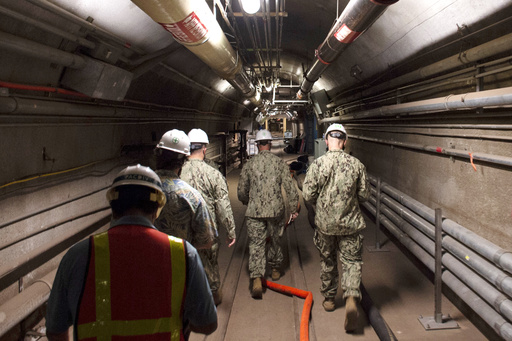
HONOLULU — According to a report released on Thursday by a U.S. military oversight agency, Navy officials did not fully grasp the risks associated with having large fuel storage tanks located above a drinking water well at Pearl Harbor, an oversight that led to the contamination of water and the poisoning of more than 6,000 individuals in 2021. This revelation highlights a concerning lapse in the Navy’s operations, particularly as detailed engineering documentation and environmental assessments were available to convey these risks clearly.
The investigation by the Department of Defense’s inspector general uncovered various shortcomings within the Navy, pointing to a critical need for improvements in the management of fuel and water systems at Joint Base Pearl Harbor-Hickam. The inspector general has recommended that the military conduct evaluations of leak detection systems across other Navy fuel facilities to prevent similar incidents in the future.
Inspector General Robert P. Storch emphasized the urgency of these actions in a statement, indicating that the Department of Defense must implement these recommendations to prevent a recurrence of such tragic events like the one that occurred in November 2021.
Constructed in the 1940s, the Red Hill fuel storage tanks were strategically built into a mountainside for protection during aerial assaults. The facility housed 20 tanks, each standing as tall as a 25-story building and capable of holding 12.5 million gallons (approximately 47.3 million liters) of fuel. Its location on a hill overlooking Pearl Harbor placed it above an aquifer that serves as a drinking water source for both the Navy and the municipal water supply of Honolulu.
Concerns about fuel leaks at the Red Hill facility have existed for years. As early as 2014, local organizations, including the Sierra Club of Hawaii and the Honolulu Board of Water Supply, urged the military to relocate the tanks to safeguard Oahu’s water resources. Nevertheless, the Navy dismissed these concerns, insisting that the island’s water was not at risk.
In May 2021, a significant leak occurred, resulting from a ruptured pipeline. Most of the spilled fuel entered a fire suppression drainage system, where it remained undetected for six months until a maintenance crew noticed the issue after a cart struck a sagging line. While they believed they had adequately cleaned the area, around 5,000 gallons (19,000 liters) of fuel remained unaddressed. By late November, this contaminated fuel entered a drain connected to a drinking water well that served approximately 90,000 individuals at the Joint Base.
The inspector general’s findings revealed the drastic impact the spill had on the local community, with 4,000 households forced to vacate their residences temporarily due to concerns over water safety. The military incurred expenses exceeding $220 million for housing displaced residents and managing the aftermath of the spill. Additionally, Congress allocated $2.1 billion to support efforts, some of which are directed toward the closure of the Red Hill facility in compliance with mandates from Hawaii’s regulatory authorities.
Further revelations from the inspector general’s report included:
1. The Navy did not inform the state Department of Health about the fuel unaccounted for following the May 2021 incident.
2. In November 2021, the Navy failed to activate emergency response protocols on four separate occasions in reaction to the water contamination, which included missed opportunities on November 20 and 28, when residents reported unusual smells.
3. The Navy issued public statements on November 21 and 22 asserting that the drinking water was safe, doing so without conducting necessary laboratory testing to validate their claims.
4. The Navy did not acknowledge the potential spread of contamination throughout the drinking water system, contrary to established emergency response directives, which may have led some residents to unknowingly use contaminated water for cooking and bathing.
In response to the findings, Hawaii’s congressional delegation, which pushed for the investigation back in 2021, expressed their concern. They characterized the Navy’s management of fuel and water operations at Red Hill and Pearl Harbor as inadequate, calling for immediate accountability and the swift implementation of the inspector general’s recommendations.
A spokesperson for the Navy stated that the findings were consistent with earlier evaluations and underscored the corrective measures currently being pursued. The Navy expressed its commitment to continual improvement to uphold Operation, Maintenance, Safety, and Oversight standards at their facilities.
